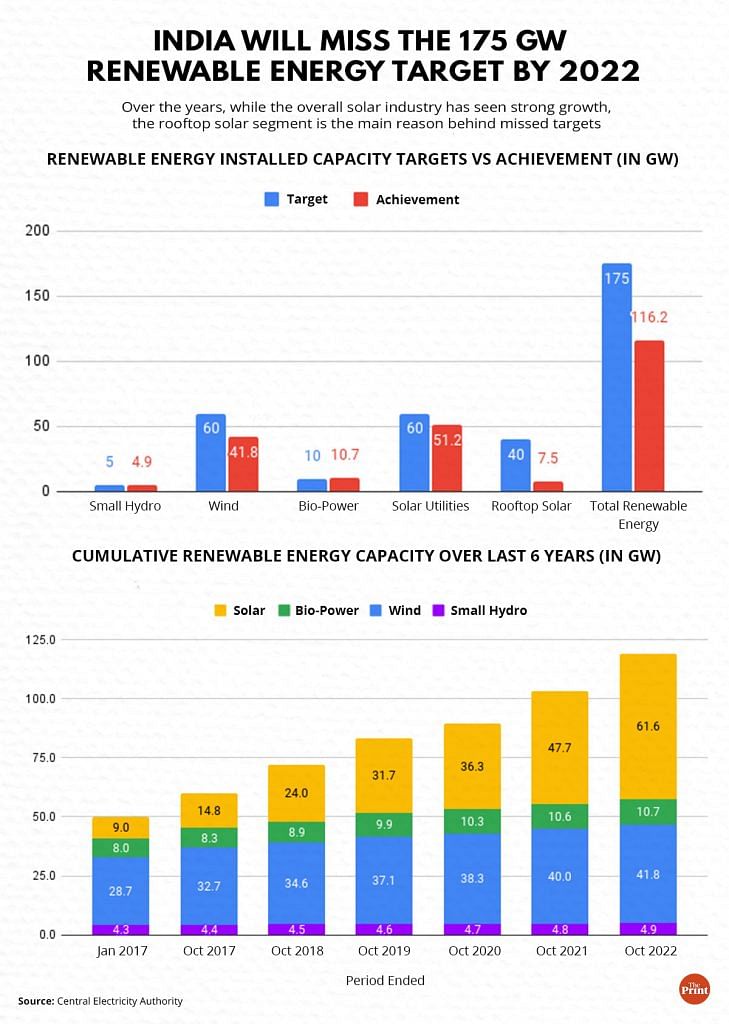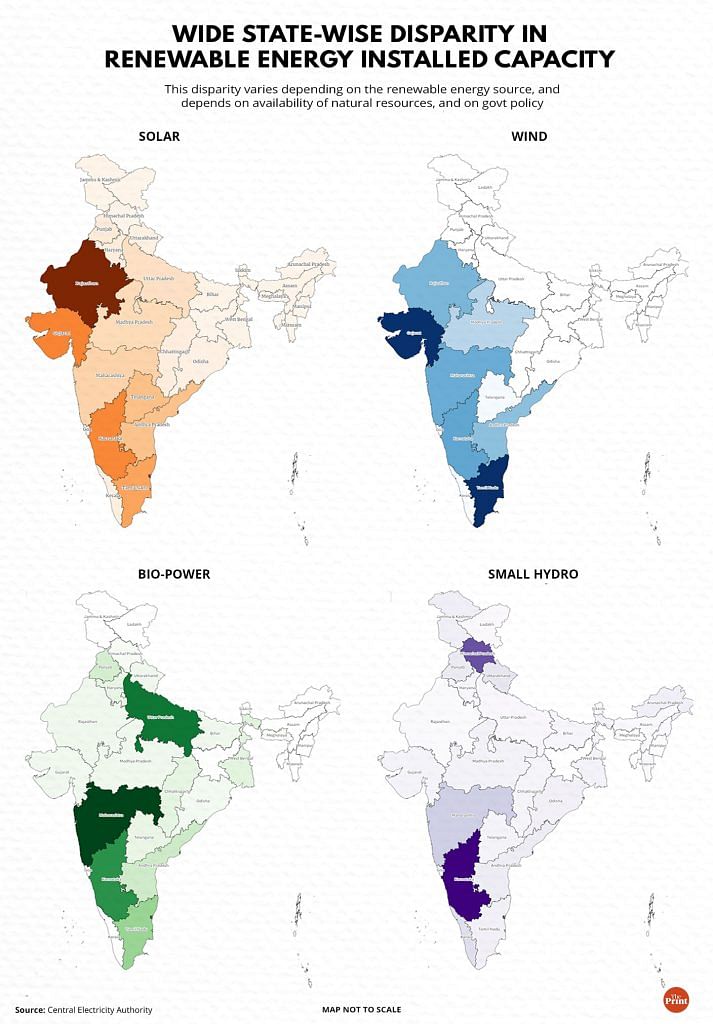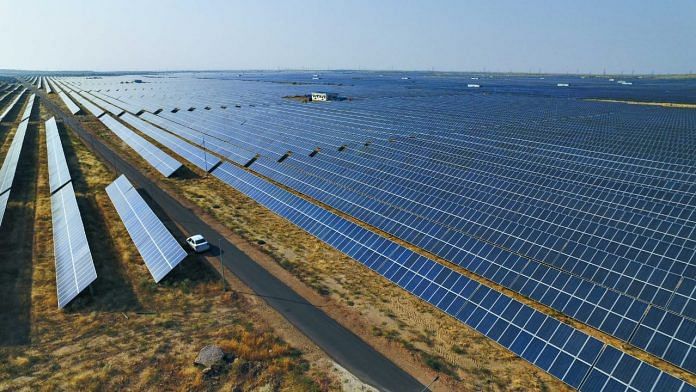New Delhi: While India has doubled down on its renewable energy commitments in the ‘Long-Term Low-Carbon Development Strategy’ it submitted this week to the United Nations Framework Convention on Climate Change (UNFCCC), or COP27, it looks like the country is set to miss one of the first commitments it had made in the renewable energy sector.
In 2014, Prime Minister Narendra Modi had promised that India would have 175 GW of renewable energy capacity by the end of 2022. As the year nears its end, data from the Central Electricity Authority shows that India has only about 116 GW of renewable energy capacity across solar, wind, bio-power, and small hydroelectric sources.
However, it must be noted that despite falling short of the 175 GW target, the achievement so far is still significant. India had only about 38 GW of renewable energy capacity as of October 2015, but this has more than tripled seven years on, as of October 2022.
Here’s a look at how India has fared in different renewable energy sectors and why experts say some have done better than others.
Also read: India’s first fully solar village in Gujarat lights up the lives of its poor residents
Highs and lows
Data shows that India’s performance has been uneven across different renewable energy sources.
On the plus side, the bio-power sector — which converts biomass fuels into heat and electricity — has exceeded its target, having achieved 107 per cent of its 10 GW target. The small hydro sector —which comprises hydroelectric units of a capacity of 25 MW or less — has also done well, with capacity at 98.5 per cent of its 5 GW target.
There have been mixed outcomes in the solar sector. Its 100 GW target is divided into 60 GW for solar utilities (large-scale power plants) and 40 GW for rooftop solar. While the solar utilities sector is currently at 85 per cent of its target, rooftop solar has only achieved 18.8 per cent or 7.5 GW of its goal.
The wind energy sector has also failed to deliver on its potential, achieving only 70 per cent of its 60 GW target, with enthusiasm in the sector waning significantly since a 2017 change in the project allocation policy, experts say.

This analysis does not include large hydroelectric projects (of a capacity of more than 25 MW) because they had not been included in the original definition of ‘renewable energy’ at the time the target was set in 2014. That inclusion came later, in 2018. If large hydro is added to the renewable energy component, the total would be 165 GW as India currently has 44 GW of large hydro capacity.
While this is a more accurate estimate of India’s current renewable energy capacity, it is not an appropriate addition when comparing achievements to the initial target set in 2014. In fact, even the government excludes large hydro projects when measuring achievements against the 175 GW target.
The analysis also shows that, while there has been some growth in all sectors of the renewable energy space since January 2017, the solar sector has driven the surge in overall capacity addition, having seen a near-seven-fold increase in capacity since then.
What is slowing the laggards?
The main laggards are the rooftop solar and wind energy sectors, which experts pin on policy issues that are disincentivising their growth.
Noting that India has made “remarkable progress” in achieving its renewable energy targets, Vibhuti Garg, South Asia director at the Institute for Energy Economics and Financial Analysis (IEEFA) told ThePrint why the solar sector has seen uneven growth.
“This progress has been largely made in the utility-scale solar projects where we see the maximum capacity being built. We will likely be achieving the 60 GW utilities scale target for solar, but we have not done well in rooftop solar,” She said.
A big reason for this shortfall in rooftop solar adoption is the way India’s electricity tariffs are structured, Garg explained. She gave the example of Australia, where she said solar rooftop picked up primarily in the residential sector, for which tariffs are higher than for commercial and industrial consumers.
She contrasted this with India, where residential tariffs are subsidised. “So, it does not make sense for an individual to put up a solar rooftop system and incur the capital cost when the tariff they pay for electricity is already relatively cheap,” she said.
The government does provide a subsidy for rooftop solar adoption, but until recently availing the subsidy was not an easy process. Further, even with the subsidy, the upfront capital cost to install a rooftop solar system was significant and there were not enough options to finance this expenditure.
“A lot of these issues have now been dealt with, with the government setting up a portal where people have easy access to government subsidies,” Garg added. “So things are being streamlined, but we have lost several years in streamlining that process.”
The other renewable energy sector that has suffered due to the government’s policy is wind. The government has set a target of 140 GW of wind energy capacity by 2030, which would mean adding nearly 100 GW of capacity between now and then — or an addition of 14 GW every year.
“Right now, the capacity addition in the wind sector is only about 1.6 GW per year, which is quite low,” said Disha Agarwal, senior programme lead at the Council on Energy, Environment and Water (CEEW). According to her, a major reason for this poor performance seems to be the change in government policy in 2017, when projects began to be awarded on a reverse bidding mechanism.
The other issue is that wind is very different from solar as an energy source, since it is much more variable — not just from one state to another, but from one project site to another. In the previous feed-in tariff (FIT) model, wind energy producers were provided a guaranteed above-market-rate tariff.
Under the reverse bidding route implemented in 2017, developers have to bid on the basis of who would be able to sell their electricity at the lowest rate. While this has worked very well in the solar sector, it has done the opposite for the wind sector.
“There has been a lowering of tariffs under the reverse bidding system, but that runs the risk of making projects unviable because the cost of producing wind-based electricity might be higher in some projects and might vary,” Agarwal added.
While she recommends a tweaking of the current approach to include appropriate provisions that reduce the risks for wind energy developers, there are reports that the central government is considering abolishing the competitive bidding process in favour of a new system that would do away with the problems associated with reverse bidding.
“Just from looking at the results of the projects that are being awarded, it looks like the projects in the previous FIT regime were more diversified across the windy states,” Agarwal added. “What we see now is that project developers are preferring to be located only in a few states, mainly Gujarat and Tamil Nadu.”
What has happened due to this, she further explained, is that several wind energy projects are competing for land, manpower, and other resources in limited areas, leading to not enough projects getting off the ground.
State-wise disparities
The data shows that there is significant disparity in the spread of renewable energy installed capacity across states. For example, in the solar sector, Rajasthan is far and away the leader, accounting for nearly a quarter of the country’s installed capacity. Gujarat, Karnataka, and Tamil Nadu together account for 35 per cent.
Tamil Nadu and Gujarat are at the forefront in the wind energy sector as well, each accounting for 23-24 per cent of the country’s total capacity. Such is the region-wise disparity in the wind sector, that only nine states have capacity to produce wind energy. This is largely because of natural reasons, as only seven states in the country are designated ‘windy’ enough to be viable for the sector.

While 29 states have some small hydroelectric power installed capacity, Karnataka (26 per cent) and Himachal Pradesh (20 per cent) have overwhelmingly large shares. In bio-power, Maharashtra takes the lead, accounting for nearly a quarter of the country’s installed capacity, followed by Uttar Pradesh (20.5 per cent) and Karnataka (17.8 per cent).
Overall, Gujarat and Karnataka feature among the top states in terms of installed capacity across most renewable energy sources.
(Edited by Geethalakshmi Ramanathan)
Also read: Renewable energy gets fresh boost as Europe finds ways to do without Russian oil & gas



